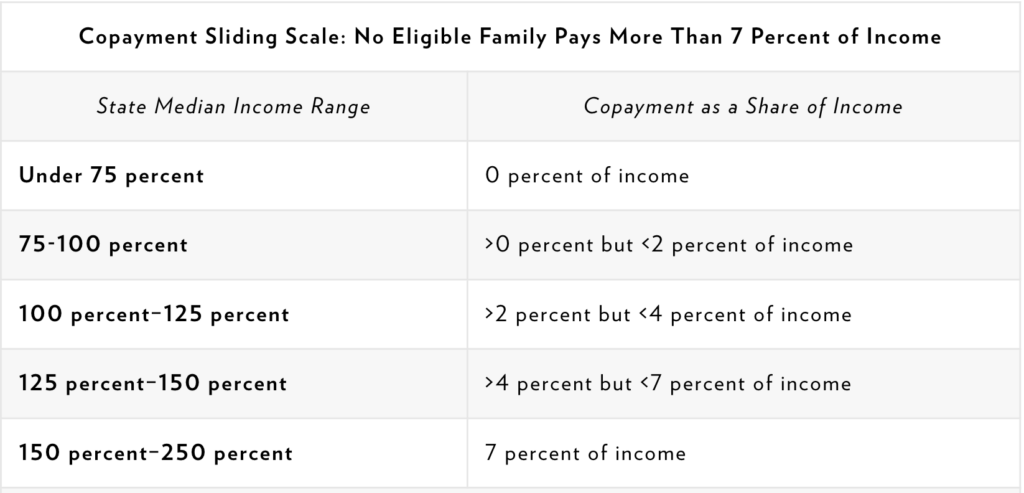Build Back Better’s provisions to lower childcare costs, improve the quality of early education and increase wages will provide immediate relief to families hit hardest by the pandemic.

This article was originally published by the Century Foundation.
The framework of the Build Back Better Act includes game-changing investments in childcare and prekindergarten that will give families the freedom to make a good living and have great care and early education for their children. This will be the most transformative investment in children and early education in generations.
The pandemic tore the invisibility cloak off of the crisis that families have faced for decades, and then made it worse:
- high prices of childcare and early learning with no support to pay them;
- more than half of families living in childcare deserts without safe, nurturing, affordable options; and
- early educators being paid $13.50 an hour on average despite their essential and complex work.
Build Back Better’s provisions could lower childcare costs for nine out of 10 families with young children in the U.S. while improving the quality of the early education they receive, raising wages and covering the costs associated with higher quality care. Universal pre-school for 3- and 4-year-olds will finally be available, and parents will have the choice to find the right program for their family in center-based, home-based, family-based, school-based and Head Start programs.
Immediately after these policies are implemented, the families hit hardest by the pandemic’s economic crisis will begin to feel the effects with free or reduced cost childcare, while the new funding will help build up the childcare and early learning sector to meet families’ needs across the nation. The more than 1 million moms still out of the workforce will begin to return to work, and others will be able to increase their hours and earnings.
These investments will have an even larger effect on the women who have long borne the brunt of the responsibility for care. Black, Latinx and immigrant women have been on the front lines of care and the pandemic, and are too often underpaid and unable to spend time with their own families. These policies will turn around these pernicious trends for women of color and ensure that women’s workforce participation—currently at its lowest since 1988—recovers quickly.
Black, Latinx and immigrant women have been on the front lines of care and the pandemic, and are too often underpaid and unable to spend time with their own families.
Finally, these investments will support the healthy development of young children in the United States, whose generation represents the country’s most diverse yet. The progressive structure of the copayment scale and the prioritization of underserved communities will ensure that those who have been historically marginalized receive the most support.
How Will It Work?
The program builds on federal–state partnerships, setting federal parameters while providing states with funding and flexibility to build the early childhood education system that families have long needed.
In the first three years, the program will be 100 percent supported by the federal government during the phase-in period. States will be able to immediately serve more children, while also developing plans with stakeholder feedback to reach all eligible families and build the supply needed so that families can access early care and education when and where they need it. Those three years will also include recruiting, training and improving working conditions for early educators and staff.
Reaching Millions of Families
In the fourth year, full eligibility begins. Like with K–12 education, every family with a 3- or 4-year old will be eligible for pre-kindergarten. Nine out of 10 families are expected to be covered by the childcare program.
To be eligible, parents with a child under age 6 must have income up to two and a half times the state median income and be engaged in a wide variety of activities, including work, job search, education or addressing health or care needs. They will be eligible for childcare assistance on a sliding scale basis.
Those with income of less than 75 percent of state median income will receive free care, and no eligible parent will be charged more than 7 percent of their family income. Most 3- and 4-year olds will be able to use pre-school during the school day and school year and childcare for after-school and summers.

Wealthier families with income above 250 percent state median income are already likely paying less than 7 percent of their income for childcare. They are not included, but are still eligible for the Child and Dependent Care Tax Credit (CDCTC), which, in 2022, will provide up to a $600 tax credit for one child and $1,200 for more than one child, as well as for the Dependent Care Assistance Program (often known as Flexible Spending Accounts for Dependent Care).
Building a Supply of High-Quality Options
While 51 percent of American families with young children live in a childcare desert (a census tract where there are more than three times as many children as licensed childcare slots), two-thirds live in infant and toddler childcare deserts. The Center for American Progress (CAP) found that “licensed childcare is more than three times as scarce for children ages 0 to 2 than it is for those ages 3 to 5.”
Ensuring that every eligible family has access to care that meets their needs is a big task. The new funding from the childcare provisions will support states to build the supply of childcare in diverse settings that families need.
Payment rates will cover the cost of high-quality childcare, including scientifically-based, developmentally-appropriate and age-appropriate strategies to promote the social, emotional, physical and cognitive development of children, including specialized training for childcare providers caring for infants and toddlers, children with disabilities and other populations. They can also use these funds to support establishing or expanding a statewide system of childcare resource and referral services to support parents and providers and other activities focused on provider preparedness, child safety, child well-being and school readiness.
Raising Wages for Early Educators
The Build Back Better plan addresses the childcare staffing shortage and improves the quality of early childhood education by investing in higher wages and training for early educators and other childcare providers.
Today, parents pay unaffordable prices for early education while early educators—the majority of whom are women, disproportionately women of color—are paid poverty-level wages. The plan will address this disconnect by using federal funding to both lower costs for families and raise wages. Specifically, the bill ensures that all early educators and staff in both childcare and pre-K are paid equivalent wages to elementary school teachers with similar credentials and experience, and at least a living wage. The plan also provides funding to support training and professional development across programs.
Today, parents pay unaffordable prices for early education while early educators—the majority of whom are women—are paid poverty-level wages.

In the first three years, states are required to use funds to increase childcare provider payment rates, including increased wages. Funds are also available to support the training and professional development of the early childhood workforce, including degree attainment and credentialing. The state plan goes into effect no later than the fourth year, and requires that states have in place a wage ladder for staff of eligible childcare providers, including a certification that states are meeting the equivalency and living wage requirements, as well as making annual cost of living adjustments.
For pre-K, similarly, by the fourth year, states must provide for salaries, and set schedules for salaries, for the staff of providers in the state pre-school program that are equivalent to salaries of elementary school staff with similar credentials and experience: At a minimum, they must provide a living wage for all staff of such providers.
Promoting Equity
After generations of leaving Black and Brown children and families behind, these policies will establish an equitable system regardless of race, zip code, economic status or disability. The policy requires that states account for how they will prioritize serving low-income children, children in underserved areas, infants and toddlers, children with disabilities and infants and toddlers with disabilities, children who are dual-language learners, and children who receive care during nontraditional hours.
In addition, some populations of children are eligible for assistance in the form of contracted slots or direct certificates available through the state regardless of parental participation in eligibility activities, including children with disabilities, children experiencing homelessness, children in foster care, children in kinship care, and children who are receiving, or need to receive, child protective services.
Transformative Change for Children, Families and Communities
The Build Back Better framework will ensure that the majority of families will pay no more than 7 percent of their income on childcare for children under 6. The framework could allow states to expand access to high-quality, affordable childcare to as many as 20 million children per year—and cover nine out of ten families across the country with young children. The United States is closer than it has been in fifty years to passing this “win for all” policy: the pathway to progress on gender, racial and income equality; healthy child development and family well-being; educational outcomes; and economic growth and prosperity.
Up next:





